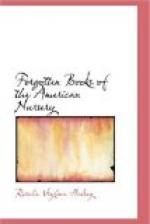This is practically Charles Lamb’s lament of some thirty years before. Lamb had despised the learned Charles, Mrs. Barbauld’s peg upon which to hang instruction, and now an American Shakespeare lover found the use of toy-books as mechanical guides to knowledge for nursery inmates equally deplorable.
Yet an age so in love with the acquirement of solid facts as to produce a Parley and an Abbott was the period when the most famous of all nursery books was brought out from the dark corner into which it had been swept by the theories of two generations, and presented once again as “The Only True Mother Goose Melodies.”
The origin of Mother Goose as the protecting genius of the various familiar jingles has been an interesting field of speculation and research. The claim for Boston as the birthplace of their sponsor has long ago been proved a poor one, and now seems likely to have been an ingenious form of advertisement. But Boston undoubtedly did once again make popular, at least in America, the lullabies and rhymes repeated for centuries around French or English firesides.
The history of Mother Goose and her brood is a long one. “Mother Goose,” writes Mr. Walter T. Field, “began her existence as the raconteuse of fairy tales, not as the nursery poetess. As La Mere Oye she told stories to French children more than two hundred and fifty years ago.” According to the researches made by Mr. Field in the literature of Mother Goose, “the earliest date at which Mother Goose appears as the author of children’s stories is 1667, when Charles Perrault, a distinguished French litterateur, published in Paris a little book of tales which he had during that and the preceding year contributed to a magazine known as ‘Moejen’s Recueil,’ printed at The Hague. This book is entitled ‘Histoires ou Contes du Tems Passe, avec des Moralitez,’ and has a frontispiece in which an old woman is pictured, telling stories to a family group by the fireside while in the background are the words in large characters, ‘Contes de ma Mere l’Oye.’”




